
STARBURSTS AND GALAXY OUTFLOWS
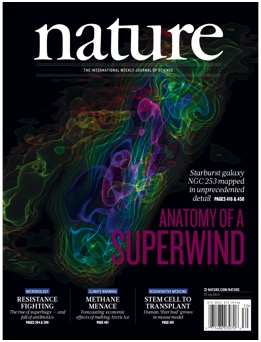
We are studying these problems in a number of nearby galaxies, particularly the prototypical starbursts M 82 and NGC 253. We have targeted the nuclear starburst NGC 253 with a number of ALMA observations. We were the first to detect and characterize its molecular wind, and we continue to study the nuclear starburst region. We have also studied outflows in the nearest quasar, located in the core of the ultra luminous galaxy F11119+3257.
This is our image of molecular gas in NGC 253, one of the nearest starbursts (Bolatto et al. 2013). It was featured in Nature as one of the 2013 images of the year.REPRESENTATIVE MULTI-WAVELENGTH GALAXY SURVEYS
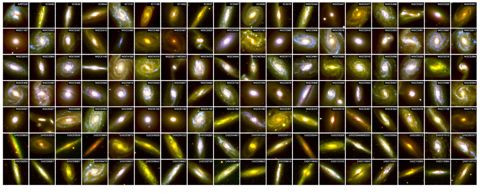
The EDGE survey studies the distribution of molecular gas in a statistically significant sample of over one hundred galaxies. The survey targets the J = 1-0 transition of CO and its 13CO isotopologue, which trace the bulk of the cold, star-forming gas. Paired with matched IFU mapping of the entire optical spectrum from CALIFA, this survey enables studies of resolved star formation efficiencies and histories, gas and stellar kinematics, nebular extinctions, and ionized gas properties across the Hubble sequence (Bolatto et al. 2017, Levy et al. 2018, 2019). We are currently pursuing ancillary observations, and proposing for a companion survey using ALMA.THE HIGH-REDSHIFT UNIVERSE
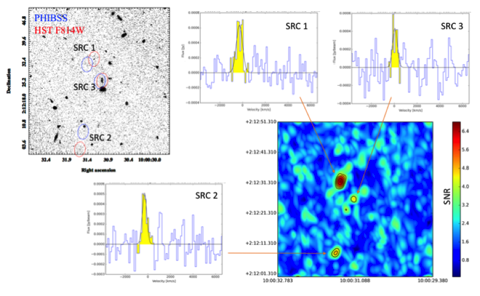
The figure show the field surrounding one of the PHIBSS targets, which is in the center. This object has two other nearby galaxies that appear to be more molecule-rich than the target source, and are not particularly apparent in the HST optical images. These chance discoveries allow us to study the clustering properties of gas-rich main sequence galaxies at z~2, and ultimately constrain the CO luminosity function at this redshift (Lenkic et al., in prep.).PROBES OF THE INTERSTELLAR MEDIUM IN GALAXIES
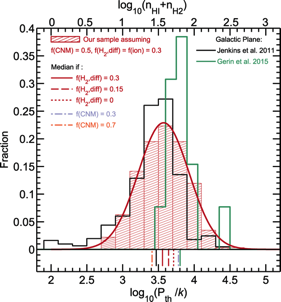
The figure shows the results of our study on the thermal pressure in the disks of nearby galaxies (Herrera-Camus et al. 2017). This is the first time data of this type has been obtained for other galaxies like the Milky-Way. The plot shows the distribution of pressures in lines-of-sight dominated by atomic gas, derived under different assumptions (different fractions of "dark" molecular gas and cold neutral medium). The distribution is very similar to values obtained in the disk of the Milky Way using two other methods by different authors. HIGH SPATIAL-RESOLUTION MOLECULAR SURVEYS OF NEARBY GALAXIES
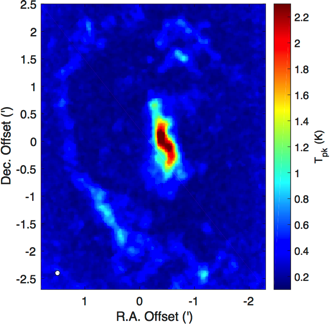
The image shows a CO 1-0 mosaic of peak temperature of the galaxy IC 342 obtained by the Argus heterodyne array at the GBT (Li et al, in prep). The beam is illustrated in the bottom left corner. The central bar and the arms are clearly visible, as are inter-arm clouds. Large single-dishes (GBT, LMT, IRAM) and interferometers (ALMA, PdBI) are the only instruments that have the sensitivity to do this type of work. MAGELLANIC CLOUD SCIENCE AND THE LOW METALLICITY UNIVERSE
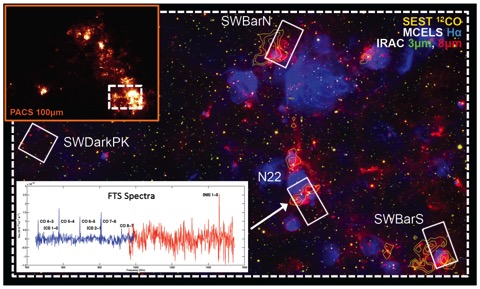
I lead and are part of a number of efforts to understand better the environment of the Clouds and other dwarf galaxies in the local universe. Some of these work has used Spitzer, Herschel, and SOFIA as well as ALMA, and in the future JWST (e.g., Leroy et al. 2007, Lopez et al. 2011, Sandstrom et al. 2012, Jameson et al. 2018). EXCITING NEW FACILITIES

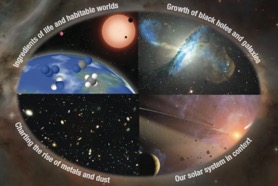
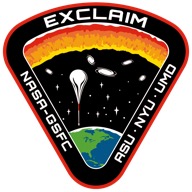
The lifeblood of astronomy is cutting-edge facilities that provide the remote-sensing data that we use to make sense of the universe that surrounds us. The images depict concepts for new facilities. The one on the left shows a ground based radio interferometer, the ngVLA, a NRAO instrument based in the Plains of Saint Augustine in New Mexico and extending with 300-km baselines, operating between 1 GHz and 116 GHz and with an order-of-magnitude improvement in collecting area over the VLA and ALMA. The one on the center shows the conceptual science that can be tackled with the Origins Space Telescope, a 5-8 m diameter cooled far-infrared NASA space observatory that can peer into the dust enshrouded cores of galaxies and detect protogalaxies at the edge of the universe. The right hand figure is the patch for EXCLAIM, a NASA-GSFC balloon experiment that will carry out intensity mapping at 500 GHz, as well as mapping of [CI] and CO in our own Milky Way and nearby galaxies.
I am the co-chair of the Science Advisory Council for the ngVLA, and participate in the science groups of the SPICA infrared telescope. I was also a member and chair of the ALMA Science Advisory Committee and led its conceptual instrumentation development plan recommendation, and part of the Advisory Board for the Green Bank Observatory.

